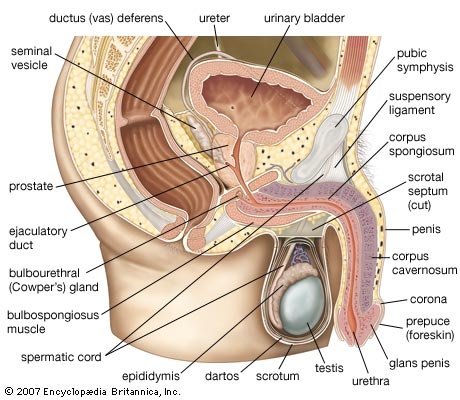penis
anatomy
 the copulatory organ of the male of higher vertebrates that in mammals usually also provides the channel by which urine leaves the body. The corresponding structure in lower invertebrates is often called the cirrus.
the copulatory organ of the male of higher vertebrates that in mammals usually also provides the channel by which urine leaves the body. The corresponding structure in lower invertebrates is often called the cirrus. The human penis is anatomically divided into two continuous areas—the body, or external portion, and the root. The root of the penis begins directly below the bulbourethral glands with a long cylindrical body of tissue known as the corpus spongiosum (or corpus cavernosum urethrae). This tissue extends through the body of the penis to the tip, where it expands into a mushroom-shaped structure called the glans penis. Running through the centre of the corpus spongiosum is the urethra, a common passage for semen and urine; the urethra ends in a slitlike opening at the tip of the glans penis. Beginning alongside of the bulbourethral glands are a pair of long cylindrical bodies called the corpora cavernosa penis. These continue through the body of the penis, occupying the sides and upper portion directly above the corpus spongiosum; they terminate immediately before the glans penis.
The human penis is anatomically divided into two continuous areas—the body, or external portion, and the root. The root of the penis begins directly below the bulbourethral glands with a long cylindrical body of tissue known as the corpus spongiosum (or corpus cavernosum urethrae). This tissue extends through the body of the penis to the tip, where it expands into a mushroom-shaped structure called the glans penis. Running through the centre of the corpus spongiosum is the urethra, a common passage for semen and urine; the urethra ends in a slitlike opening at the tip of the glans penis. Beginning alongside of the bulbourethral glands are a pair of long cylindrical bodies called the corpora cavernosa penis. These continue through the body of the penis, occupying the sides and upper portion directly above the corpus spongiosum; they terminate immediately before the glans penis.The corpora cavernosa consist of empty spaces divided by partitions of tissue. The tissue consists of muscle, collagen (a fibrous protein), and elastic fibre. The corpora cavernosa are termed erectile tissue (see erection), because during sexual excitation, their fibrous tissue is expanded by blood that flows into and fills their empty spaces. The blood is temporarily trapped in the penis by the constriction of blood vessels that would normally allow it to flow out. The penis becomes enlarged, hardened, and erect as a result of this increased blood pressure. The corpus spongiosum is also considered erectile tissue. This area, however, does not become as enlarged as the other two during erection, for it contains more fibrous tissue and less space; unlike the corpora cavernosa, the corpus spongiosum has a constant blood flow during erection.
The corpora cavernosa and corpus spongiosum are enclosed by a circular layer of elastic tissue. This in turn is covered by a thin layer of skin. The skin, which is slightly darker in colour than the rest of the body, is loose and folded while the penis is in a flaccid state. At the beginning of the glans penis, a circular fold of skin, commonly called the foreskin (or prepuce), extends forward to cover the glans. At birth or during early childhood, the foreskin may be removed by an operation called circumcision (q.v.).
- Robert Ballard
- Robert Barclay
- Robert Barnes
- Robert Benchley
- Robert Blair
- Robert Blake
- Robert B. Laughlin
- Robert Bloomfield
- Robert Bly
- Robert Bolt
- Robert Bosch
- Robert Bostwick Carney
- Robert Boyd, 1st Lord Boyd
- Robert Boyd Boyd, 1st Lord
- Robert Boyle
- Robert Bresson
- Robert Bridges
- Robert Brown
- Robert Browne
- Robert Browning
- Robert Bruce Foote
- Robert Burns
- Robert Burns Woodward
- Robert Burton
- Robert Bárány